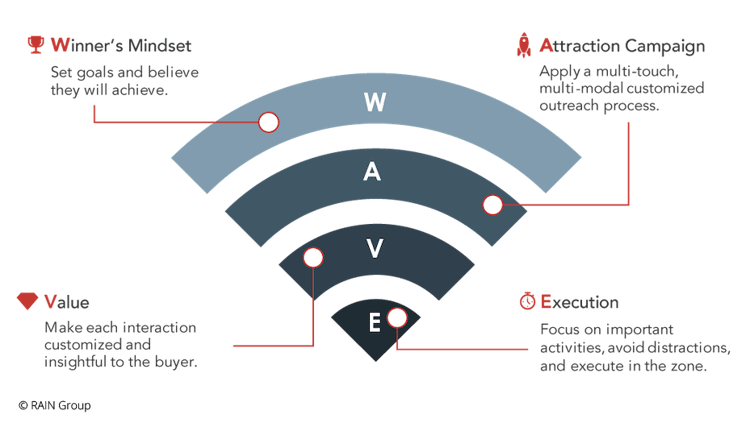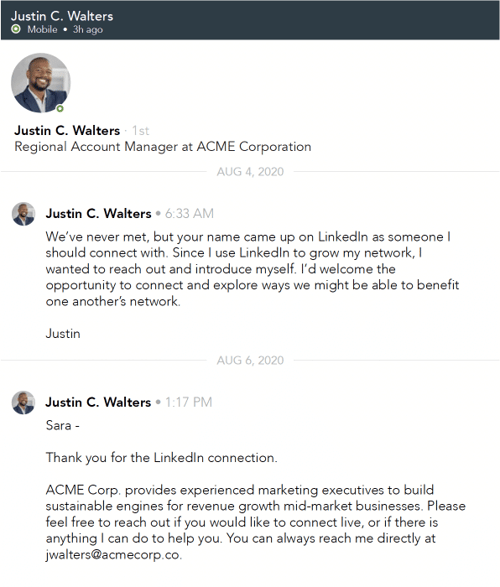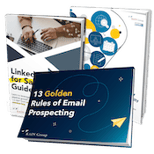Tell me if you’ve heard this one before: “Put me in front of ten buyers and I'll close seven of them. All I need is more meetings.” I hear this from sellers all the time. They're convinced they'll get the hits if they just get more at-bats.
But where are those at-bats going to come from? No salesperson ever hit home runs by sitting back and waiting for the phone to ring or their email to ding. To succeed in sales, you need to proactively generate a consistent stream of new leads to fill the front end of the pipeline.
WAVE Method: The Cure for Feast-or-Famine Sales Pipelines
That's not as easy as it used to be. Today, more people are working, buying, and selling virtually. Many of the organic opportunities we used to rely on to create sales opportunities have dramatically declined. Trade shows and networking events are few and far between.
You have to take the lead to create conversations and make the most out of the opportunities you have. More importantly, you need to work hard to understand your buyers so you can be more valuable to them. That’s what top performers are so good at.
Learn how to use AI to simplify your prospecting. >>
According to our Top Performance in Sales Prospecting research, top performers get nearly 2x as many high-quality meetings. How? They’ve thoroughly assimilated the four cornerstones of prospecting success, which we’ve distilled into our WAVE framework:

1. Winner's Mindset
Prospecting is a great motivational challenge, and you’ll need a winner’s mindset to fill your pipeline. How you think about yourself and prospecting correlate to success. Our research has shown a marked difference in the attitude of top-performing sellers compared to others.
Top Performers are more likely to enjoy the time they spend prospecting. They feel energized after prospecting, not deflated. Meanwhile, The Rest are more likely to say prospecting is the least appealing part of what they do in sales. Guess which group is better at keeping their pipelines full?
When reaching out feels like the hardest part, consider this (source: Top Performance in Sales Prospecting):
- 82% of buyers accept meetings at least sometimes with sellers who reach out
- 71% of buyers want to hear from sellers at the earliest part of their buying process
- 75% of purchases are strategic, yet sellers propose strategic ideas only 14% of the time
As the data indicates, the at-bats are available. The question remains: what’s stopping you from getting them?
2. Attraction Campaign
Now that you’ve awakened your winner’s mindset, it’s time to create an organized sequence of outreach across multiple channels. This is how you break through! The days of paper-based directories and smile-and-dial are long gone. Things have changed.
Today’s buyers are:
- Pressed for time
- Bombarded by sellers
- More informed
- Active on a variety of digital channels
In this environment, it takes a lot for sellers to break through. It takes even more for a buyer to be intrigued enough to respond and accept a meeting. That said, sellers who create customized (and I mean manually customized) content and messages, and who reach out across channels in coordinated campaigns designed to attract buyers, succeed more often than those who don't.
We call this an attraction campaign. Here’s how to build yours:
Identify the list of people and businesses you want to secure a meeting with.
This should include existing buyers and accounts, past buyers, past opportunities, members of your network, and high-value targets. Once you know who you're targeting, you can organize them appropriately and create an offer tailored to each buyer, industry, and business situation.
Decide how you'll reach out and how often.
According to our research, 43% of buyers who accept meetings say it's okay for sellers to contact them five or more times before getting through. Devise a sequence that uses multiple touchpoints, including email, LinkedIn, and phone. Here’s an example sales outreach sequence:
- Touch 1, Week 1: Email
- Touch 2, Week 1: LinkedIn Connection
- Touch 3, Week 2: Email
- Touch 4, Week 2: Phone/Voicemail
- Touch 5, Week 2: Email
- Touch 6, Week 3: LinkedIn InMail
- Touch 7, Week 3: Phone/Voicemail
- Touch 8, Week 3: Email
Do your research ahead of time to customize and add value to each outreach.
A tool like LinkedIn Sales Navigator can provide key pieces of information about your buyer that you can use to customize your messages, making them relevant to each buyer.
What Makes a Strong Offer?
Offers aren’t one size fits all. You often need a collection of different offers tailored to the buyer, their industry, and their business situation.
For example, you could have a trigger set up for when one of your top accounts hires a new COO to send an email about the “5 things COOs in <insert industry> need to do in their first 90 days” compiled from your experience and research.
Whatever your offer is, it needs to be highly relevant and exceptionally compelling.
3. Value
An astounding 58% of meetings aren't valuable to buyers. You must have a compelling, value-based reason for buyers to want to meet with you, and you must deliver that value in your meetings.
Buyers are looking for your advice. They're awash with information about a million things, let alone the solution you’re offering. When we asked sellers about the effectiveness of various content offers in their prospecting efforts, we found remarkable differences between Top Performers and The Rest.
Here’s how Top Performers tend to create value:
- 100% customized content: Sellers at top-performing organizations are better at reaching out to individuals with better research and content, stronger focus on value, and better prospecting execution.
- Recommending best practices: Buyers love to know what works and what doesn't. Top Performers know how to recommend best practices that help prospects do their jobs better.
- Primary research: Top Performers create research that buyers want to see (financial impact, for instance), and do a better job using it to capture buyer attention and interest.
Personalization is key. No one wants to feel like they’re being spammed by a bot, like I did after receiving this outreach on LinkedIn:

This is why it’s so important to understand value from the buyer's perspective and what they're looking for. Essentially, value boils down to each buyer's thoughts on the 4 Whys:
- Why act?
- Why now?
- Why us?
- Why trust?
The more effectively you can build a case that answers these questions, the better you'll be able to grab buyers' attention and compel them to meet with you.
What Offers Do Buyers Find Valuable?
According to our research, C-level and VP buyers are more likely to be influenced to take a meeting by ROI cases (75%) and 100% customized content written just for them (75%), compared to directors and managers.
What’s more:
- 69% want primary research data relevant to their business
- 66% want insights on the use of products or services to solve business problems
- 63% want insights into new and emerging business issues or market trends
Learn more about sales prospecting offers that work in our article, Sales Prospecting: Tips, Techniques, and Strategies.
4. Execution
How you manage your time, energy, and focus matters. The first three elements of the WAVE framework support this last one: execution.
The best prospectors are focused and motivated. They understand how to:
- Maximize time, energy, and focus for prospecting
- Develop the right prospecting skills to impress buyers
Nowhere in selling do sales professionals need more focus, discipline, and execution than they do in proactively reaching out to generate new conversations.
They maximize their execution (and you can too) by adopting these three habits of extreme productivity:
Plan & Share Your Actions
Try writing out your weekly actions and tracking your progress with a colleague. Our research found that the extremely productive people (The XP) were 3.4x more likely to track their progress with an accountability partner.
A strong focus on weekly actions—just 20 minutes a week planning them—and then tracking your progress on those actions will help you feel more motivated.
Calendar Your TIME
For any activity you need to do—for anything important that requires you to be proactive—you have to get started! Many people know they need to get started, then don’t.
In our research, we found that calendaring investment activities is a key driver of extreme productivity: the XP are 2.7x more likely to calendar their time and 4x more likely to get their day started with the one activity they believe will most drive their success that day—what we call the Greatest Impact Activity (GIA).
What Is Investment TIME and GIA?
Your Investment TIME is the time spent to complete an activity that will yield outsized returns.
Your Greatest Impact Activity (GIA) is the one investment activity you prioritize on a given day.
Sprint into the Zone
The zone (also known as flow) is the mental state where a person performing an activity is fully immersed in a feeling of energized focus, full involvement, and enjoyment in the process of the activity.
If you want to maximize effort per work hour, get in the zone. If you want to get in the zone, the best thing to do is establish a daily routine of obsessed, planned sprints (working on a planned activity for 20 minutes minimum with timer on counting up). Is there a time of day in which you’re most productive? This is a good place to start.
Tips for Cleaning Up “Mirage” Pipelines
Once you’ve begun filling your pipeline it’s all too easy to leave it unattended. The pipeline looks full! Bursting. It stays like that for 2 months, 5 months, 10 months. More keeps going in, but nothing comes out the other end.
Too many sellers have lots of opportunities in their pipelines that shouldn't be there. Neither managers nor sellers want mirage pipelines with visions of promised lands that simply aren't there. For managers, it prevents accurate forecasting. For sellers, it’s a frustrating recipe for missing quota.
Here’s how to clear your sales pipeline of dead wood:
- Want to do it: Wanting to have a clean, real pipeline means being brave enough to show a pipeline to managers that looks thin, and getting over your need for approval or fear of no.
- Maintain at least a four-stage pipeline: The names may be different in your organization, but you should manage a pipeline in some semblance of four categories:
- Suspect: Someone who indicates interest, but who may not have financial ability to buy, authority to buy, need, or timeframe. Or, someone you’re trying to persuade who does have authority and financial ability.
- Prospect: Someone who indicates interest and need and has budget, but you might not be talking to the right person or people with authority yet, and you may not have a timeframe.
- Qualified prospect: Someone who meets the FAINT criteria as a qualified buyer, and you have the right decision roles involved, with authority and urgency to move forward.
- Win-ready: You’re in active pursuit of a win in the short-term. You have a proposal out and are expecting a go/no-go decision in the near-term.
- Move deliberately on unresponsive leads: Make the decision to keep or cut prospects who have gone dark.
-
Reverse direction: Change the dynamic. Establish yourself as a peer whose time is as important as theirs, and don’t be afraid of hearing—even inspiring—a "no" response.
The reverse direction is a tactic where you let the buyer know you'll no longer reach out to them and if they’re interested they can respond, or not.
You can use the reverse direction strategy at any stage of the pipeline after a few regular outreach attempts have gone into the abyss. Use phone and email at a minimum, and LinkedIn, text, and other outreach methods where it makes sense.
Example Reverse Direction Email
You can tailor a reverse direction message to suit contacts in any stage of the pipeline. Here’s an example of an email sent to a qualified prospect.
Dan,
Sorry we haven't been able to reconnect since our meeting on the fourth. I'm guessing since I haven’t heard back from you that you're not interested, have moved on, or it’s not a priority. If that's the case, and I don't hear back, I won't be reaching out anymore.
If, however, I'm wrong and there's another reason I haven't heard back, please drop me a line and we can talk and see what's possible.
Let me know what you're thinking because I think there's an opportunity here for you to <insert something important / key benefit>.
Best regards,
Alicia
When you send reverse direction messages, you'll get one of three reactions:
- Yes, I'm still interested! (You can pursue from here.)
- No, you’re right. We’ve moved on, selected something else, etc. (You can remove from your pipeline.)
- No response. (You can remove from your pipeline.)
Frequently, you’ll resurrect some sales you thought might be dead. It's quite common that the last communication inspires an "I'm still here!" kind of response, allowing you to re-engage something you thought was lost.
Discontinuing contact after a reverse direction message doesn't mean you can never contact them again, either. Give a high potential buyer a rest for a few months and when you have something of substantial value to offer, such as new research, reach out.
5 Tips to Grow Your Pipeline
Even with the WAVE Method in mind, it can be challenging to know where to start. Here are 5 ideas to start proactively expanding your pipeline:
1. Lead with Ideas
In the public perception, products and services have become commoditized. With the increase of information available online and the ability to purchase more online, buyers have a lot more power than they've ever had before.
Differentiate yourself by sharing your ideas and valuable advice with buyers. When reaching out for meetings, lead with your ideas. For instance, you might suggest meeting to review new research in your area of expertise. Do this and you'll not only fill the pipeline, but also win more often.
2. Develop a Prospecting System
Prospecting has always been a challenge for sellers, and it's only getting harder. Buyers are flooded with phone calls, emails and information. To break through all the noise, you need to have a prospecting system in place that involves reaching out to potential buyers on a regular basis.
Create customized content and messages, and reach out using multiple channels—phone, email, social media, snail mail. According to new research, it takes an average of eight touches to get through and generate a conversion with targeted buyers. Don't give up after two or three outreach attempts.
3. Create Opportunities with Current Clients
One of the fastest ways to grow your pipeline is by creating new opportunities with your current clients. Across all the products and services you offer, are each of your clients buying as much as they should be from you? The answer to this question is typically a resounding no.
Connect with your current clients and continue to strengthen those relationships. Get to know their business and use this opportunity to uncover new areas where you could help. You need to build fluent product knowledge and ask the right questions to make the most appropriate recommendations.>
4. Ask for Referrals
As simple as it sounds, most sellers aren't very good at asking for referrals. One of the best ways to get more referrals is to give referrals first. Connect your clients with people they'd like to meet. Then, when it's time for you to request a referral, they'll be more likely to give you one.
5. Connect with Past Prospects and Clients
Another trove of new pipeline opportunities is with your past clients and prospects. Just because they didn't buy from you, or stopped buying from you at one point, doesn't mean they shouldn't be buying from you now.
Nurture those past prospects and clients. Stay top of mind. Be proactive and schedule meetings to discuss what's going on with their business today. With change comes opportunity, and change is always happening.
Keep Your Pipeline Filled and Healthy
Fill your pipeline and keep it healthy with the WAVE method I’ve laid out above: winner’s mindset; attraction campaign; value; and execution. As you bake this framework into your sales prospecting discipline, you’ll inevitably build a cleaner, more honest pipeline that actually wins you business.






